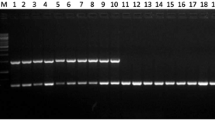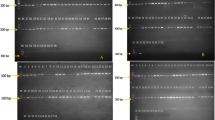Abstract
Cassava (Manihot esculenta Crantz) is an increasingly important tropical root crop. It is however affected by an endemic disease in the Caribbean called Super-elongation caused by the fungus Sphaceloma manihoticola. Traditional methods of detection and laboratory confirmation of S. manihoticola infection depend on the observation of seasonally variable stem elongation symptoms, and confirmatory fungal growth of cultures that can take up to four weeks, due to the slow-growing nature of the pathogen. The elongation symptoms observed are due to the production of large amounts of gibberellin GA4 by the pathogen. In this study, specific PCR primers were developed to target the Smp450-2 gene (Gen Bank Acession AM 886290), in the gibberellin biosynthesis gene cluster of S. manihoticola. Shade-house plants were inoculated with a suspension of S. manihoticola and DNA extracted over a 28-day period, followed by PCR amplification using the Smp450-2 primers. Detection of S. manihoticola in infected samples was possible 7 days post-infection in at least one local cassava variety, whereas visible disease symptoms appeared after 21 days. This PCR based method was also able to detect the pathogen in leaves and cankers of diseased field tissues, but not in disease-free material from either the laboratory or cassava fields. A new approach for the detection of S. manihoticola causing Super-elongation disease in cassava is therefore presented, and its potential use as a diagnostic tool for early detection of this disease is explored.



Similar content being viewed by others
References
Alvarez, E., & Molina, M. L. (2000). Characterizing the Sphaceloma Fungus, causal agent of superelongation disease in Cassava. Plant Disease, 17, 423–428. doi:10.1094/PDIS.2000.84.4.423.
Alvarez, E., & Meija, J. F. (2003). Molecular and pathogenicity characterization of Spahaceloma manihoticola isolates from South Central Brazil. Plant Disease, 87(11), 1322–1328.
Alvarez, E., Mejia, J. F., & Valle, T. L. (2003). Molecular and pathogenicity characterization of Sphaceloma manihoticola isolates from South-Central Brazil. Plant Disease, 87, 1322–1328. doi:10.1094/PDIS.2003.87.11.1322.
Bömke, C., Rojas, M. C., Gong, F., Hedden, P., & Tudzynsk, B. (2008). Isolation and characterization of the Gibberellin Biosynthetic gene cluster in Sphaceloma manihoticola. Applied and Environmental Microbiology, 74, 5325–39. doi:10.1128/AEM.00694-08.
Bömke, C., & Tudzynski, B. (2009). Diversity, regulation, and evolution of the gibberellin biosynthetic pathway in fungi compared to plants and bacteria. Phytochemistry, 70, 1876–93. doi:10.1016/j.phytochem.2009.05.020.
Chandler, F. (1992). Commercial cassava production. Bridgetown, Barbados: Caribbean Agriculture Research and Development Institute: CARDI Factsheet CP-F/89.
Cock, J.H. & Lynam, J. K. (1991). La yucade América Latina. In: Economía en la Proyectos integrados de yuca. C. A. Pérez Crespo, ed. Centro Internacional de Agricultura Tropical (CIAT), Cali, Colombia. Documento Trabajo 79, 18–27.
FAO (2008) Cassava for food and energy security. FAO Newsroom. http://www.fao.org/newsroom/en/news/2008/1000899/index. Acessed 19 Nov 2011
El-Sharkawy, M. A., Cock, J. H., Lynam, J. K., Hernández, A. D. P., & Cadavid, L. F. (1990). Relationships between Biomass, Root-yield and Single-Leaf Photosynthesis in Field-Grown Cassava. Field Crops Research, 25, 183–201. doi:10.1016/0378-4290(90)90002-S.
Krauz, (1976). The Superelongation Disease of Cassava. Ithaca, NY, USA: Cornell University, PhD thesis, 81pp.
Lee, S. B., & Taylor, J. W. (1990). Isolation of DNA from fungal mycelia and single spores. In M. A. Innes, D. H. Gelford, J. J. Sninsky, & T. J. White (Eds.), PCR Protocols—A Guide to Methods and Applications (pp. 282–287). San Diego, CA: Academic Press Inc.
Linnemanstons, P., Voß, T., Hedden, P., Gaskin, P., & Tudzynski, B. (1999). Deletions in the gibberellin biosynthesis gene cluster of Gibberella fujikuroi by restriction enzyme-mediated integration and conventional transformation-mediated mutagenesis. Applied and Environmental Microbiology, 65, 2558–2564.
Prochnick, P., Marri, P. R., Desany, B., Rabinowicz, P. D., Kodira, C., Mohiuddin, M., Rodriguez, F., Fauquet, C., Tohme, J., Harkins, T., Rokhsar, D. S., & Rounsley, S. (2012). The cassava genome: current progress, future directions. Tropical Plant Biology, 5, 88–94. doi:10.1007/s12042-011-9088-z.
Rademacher, W. (1992). Occurrence of gibberellins in different species of the fungal genera Sphaceloma and Elsinoe. Phytochemistry, 31, 4155–4157.
Reeder, R., Kelly, L., Hill, A. A., & Ramnarine, K. (2008). Superelongation disease, caused by Elsinoe brasiliensis, confirmed on cassava in Trinidad and Tobago. Plant Pathology, 58, 800. doi:10.1111/j.1365-3059.2009.02045.x.
Rozen, S., & Skaletsky, H. (2000). Primer 3 for general users and for biologist programmers. In: S. Misener & S. A. Krawetz (Eds.), Methods in Molecular Biology: Bioinformatics methods and protocols, vol 132 (pp. 365-386). Totowa, NJ: Huumana Press Inc.
Titus, P., Lawrence, J., & Seesahai, A. (2011). Commercial Cassava production. Bridgetown, Barbados: Caribbean Agriculture Research and Development Institute. CARDI Bulletin no. 5 (Technical Bulletin Series).
Zeigler, R. S., Powell, L. E., & Thurston, H. D. (1980). Gibberellin A4 Production by Sphaceloma Manihoticola, causal agent of Cassava Superelongation Disease. Phytopathology, 70, 589–593.
Zeigler, R. S., Alvarez, E., & Lonzano, J. C. (1983). Characteristics cassava resistnce to Superelongation disease. Tropical Pest Management, 29(2), 148–158. doi:10.1080/09670878309370791.
Zeigler, R. S., & Lozano, J. C. (1983). The relationship of Sphaceloma and Elsinoe species pathogenic on cassava and other members of the Euphorbiaceae in Central and South America. Phytopathology, 73, 293–300.
Acknowledgments
Thanks to the School for Graduate Studies and Research and the Post Graduate Research Fund at UWI Cave Hill for supporting this study and the Ministry of Agriculture Barbados and CARDI for supplying planting material.
Conflict of interset
The authors declare no conflict of interest.
Author information
Authors and Affiliations
Corresponding author
Rights and permissions
About this article
Cite this article
Alleyne, A., Gilkes, J. & Briggs, G. Early detection of Super-elongation disease in Manihot esculenta Crantz (cassava) using molecular markers for gibberellic acid biosynthesis. Eur J Plant Pathol 141, 27–34 (2015). https://doi.org/10.1007/s10658-014-0517-3
Accepted:
Published:
Issue Date:
DOI: https://doi.org/10.1007/s10658-014-0517-3




